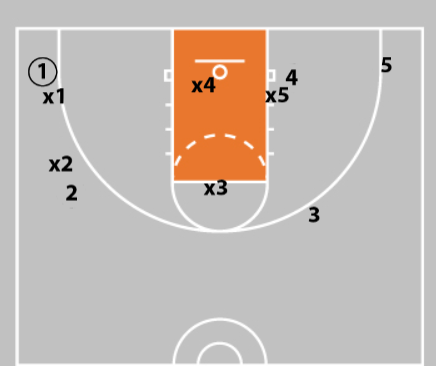Create Pace Without the Press: The Power of Forcing Left
Playing fast is a conundrum for many coaches. I haven't met too many who don't want to play fast offensively.
Almost all coaches see the benefits of transition offense.
However, a lot of coaches are reluctant to pick a corresponding defense. As a result, they have an offensive goal that their defense doesn't support.
Why do many coaches end up with this dilemma? For many, it's a lack of comfort with pressing. Pressing would be the most natural way to create an up-and-down game. A lot of coaches are uncomfortable with some of the drawbacks of pressing. Others are worried about a lack of depth.
Which brings us back to square 1: how do you consistently create tempo without playing an aggressive, pressing style of defense?
WATCH here as Coach Rob Brost explains the solution - the Man Left.
How Forcing Left Unintentionally Speeds Up Your Opponent
The goal of the Man Left is to get the ball to the left corner.
That is achieved by 3 key actions:
- The on-ball defender forcing the ball to the left.
- Defenders to the left of the ball being in the gap to help on drives & allow passes going down & left.
- Defenders to the right of the ball denying.
Done successfully, the court should look something like this:

At this point, the offensive player doesn't have many options. Another core element of Man Left is this:
- Take away the right-hand drive & the shot. Compete on the left-hand drive.
In the picture above, 1's only option is to drive the ball left.
Even when the ball is not in the corner, the offense is easily distorted. Most offenses enter the ball to the right side, and the Man Left doesn't allow that.
What you end up with is this: your opponent can't run their offense. Consequently, their players must create offense with their weak hand, while pressured.
What results from that:
- Turnovers - most players are not as skilled dribbling with their left hand. Even more glaring is the inability of most players to pass with their left hand.
- Bad shots - because you are taking away right-hand drives & open 3's, your opponent ends up shooting contested, off-the-dribble jumpers going left. Those don't go in very often.
How Forcing Left Intentionally Speeds You Up
We've covered the results of the Man Left. Now let's look at how that translates to transition offense.
It's pretty simple.
- Turnovers lead to a lot of fast breaks and advantage situations for your team. These result in high percentage shots.
- Bad shots by your opponent result in you not having to take the ball out of the net. When you take it out of the net, you have to play against a set defense.
Instead, you can get the rebound and go. This allows you to run off every rebound.
In sum, your defense is fueling your offense.
The Perfect Defense for Transition Offense
What's great about the Man Left is its versatility. If you want to play it as a full-court defense, Coach Brost will tell you how.
If you don't want to press, you can play it exclusively in the half-court and still create tempo.
I've even run a Run & Jump press and then transitioned to the Man Left once the press was broken. This put pressure on our opponent throughout the possession.
Your lineup & risk tolerance will dictate how you use the Man Left. What's reassuring is there's more than one way to do it . . . and they all lead to the same result - frustration for your opponent, and easy buckets for you!
A Natural Complement to Man Left Defense
If you need more proof of how the Man Left & transition offense go together, check out Get Comfortable Playing At An Uncomfortable Pace With Rob Brost.
Coach Brost will teach you the transition offense system that he uses to complement the Man Left.
In tandem, the systems create organized chaos - you being the team that's organized, your opponent being caught in the chaos!
What do you think? Let us know by leaving your comments, suggestions, and questions...
|
|||


 Facebook (145k Followers)
Facebook (145k Followers) YouTube (152k Subscribers)
YouTube (152k Subscribers) Twitter (33k Followers)
Twitter (33k Followers) Q&A Forum
Q&A Forum Podcasts
Podcasts